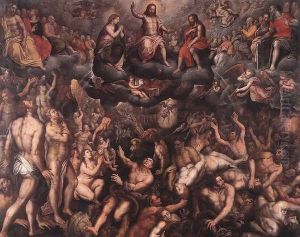Raphael Coxcie Paintings
Raphael (or Raphaël) Coxcie, also known as Raphael Coxie or Raphael van Coxcie, was a Flemish Renaissance painter who was born in Mechelen (now part of Belgium) in 1499. He is sometimes referred to as the 'Flemish Raphael' for his stylistic emulation of the Italian master Raphael Sanzio. His father, Michiel Coxcie, was also a prominent painter, and it is likely that Raphael received his initial training from him. The younger Coxcie's artistic talents were recognized early on, and he was sent to Italy to further his education in the arts. This journey was instrumental in shaping his style, as he came into direct contact with the works of Italian Renaissance masters.
During his stay in Italy, which lasted about a decade, Coxcie studied the works of Italian artists, particularly those of Raphael, whose influence would be a defining element in Coxcie's own paintings. His works from this period show a strong understanding of Italian Renaissance techniques and an ability to adapt them to Northern European artistic traditions. Upon his return to the Low Countries around the 1530s, Coxcie became a court painter to Emperor Charles V, a position that brought him considerable prestige and commissions.
Coxcie's body of work includes religious compositions, altarpieces, mythological scenes, and portraits. He was also involved in the design of tapestries and stained glass. His painting style is characterized by a harmonious use of color, detailed depiction of fabrics and textures, and a graceful portrayal of figures. Among his notable works are the altarpiece 'The Martyrdom of Saint Sebastian' and his contribution to the restoration of the Ghent Altarpiece originally by the Van Eyck brothers, which he undertook in the mid-16th century.
Raphael Coxcie's influence extended beyond his lifetime as he became a central figure in the transition from the Gothic to the Renaissance style in the Low Countries. He trained numerous apprentices who would carry on his techniques and stylistic approaches. His sons, Michiel Coxcie the Younger and Raphael Coxcie II, also became painters, although they did not achieve the same level of prominence as their father.
Coxcie's death in 1592 marked the end of an era for the Flemish Renaissance. He was buried in the St. Rumbold's Cathedral in Mechelen, the city of his birth. Coxcie's legacy lives on through his contributions to the Flemish artistic tradition and the preservation of his works in various European art museums and churches.
